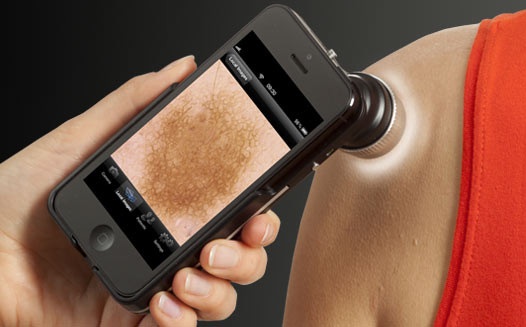 A small validation study in Sweden suggests that teledermatology, conducted using an iPhone, a dedicated app, and a connected dermascope, can be roughly as effective as a face-to-face dermatology consultation.
A small validation study in Sweden suggests that teledermatology, conducted using an iPhone, a dedicated app, and a connected dermascope, can be roughly as effective as a face-to-face dermatology consultation.
The study of 69 lesions (the number of patients is not specified) was conducted at Sahlgrenska University Hospital in Sweden and published in the journal Dermatology Practical and Conceptual. The lead researcher, Dr. Alexander Borve, is also the founder of iDoc24, the app used in the study. Borve is an orthopedic surgeon, not a dermatologist, and was not involved in any of the diagnoses.
In the study, patients who came in for face to face dermatology consults first had their lesions photographed with the iPhone and connected dermoscope, a German-made device called a Handyscope by FotoFinder. (This device is not FDA-cleared but the company said it may register as Class I in the future.) The images were sent to two separate teledermatologists, whose diagnoses were compared with the face-to-face diagnosis.
The teledermatologists were comparable to the face-to-face dermatologist, but over all not as accurate. The in-person dermatologist diagnosed 46 of the 69 lesions accurately, a rate of 66.7 percent, while the teledermatologists accurately diagnosed 42 (60.9 percent) and 35 (50.7 percent), respectively. However, when researchers looked only at the classification of benign vs. malignant, accuracy went up considerably, with the in-person dermatologist at 87 percent accuracy and the teledermatologists at 75 and 79 percent respectively.
The study authors conclude that teledermatology could be useful as a screening device or a triage tool, with a clear implication that it is not sufficiently accurate to replace face-to-face dermatology. Borve told MobiHealthNews in an interview that the study also found that 10 to 15 percent of the time, the face-to-face doctor found an additional lesion that turned out to be dangerous in the course of a full body screening.
"It's a good way to screen one mole, but it's not a good way to screen a whole patient," he said. "One thing you have to understand is, just taking a picture with your iPhone, we cannot diagnose from that, but we can screen it, give a probable diagnosis and treatment information and education."
The study as conducted, with a $600 dermascope, doesn't have clear indications for direct to patient, "store and forward" teledermatology. However, there are relevant consumer applications: In addition to iDoc24's direct to consumer application, where users can pay $39.99 to anonymously submit pictures of skin lesions or moles and receive suggestions from dermatologists, the company offers iDoc24Pro to general practicioners who can use it for in-office consultations. And the startup is conducting a pilot where dermascopes are placed in pharmacies and patients can send off for their consultation in-store.
Borve said he's working on a follow-up study with a much larger sample: around 900 patients. The study will include four dermatologists and 122 general practitioners. Preliminary results in the second study suggests that teledermatology triage can reduce the average time for diagnosis of a malignant melanoma from 46 days (the average with traditional paper referrals) to 14 days.













